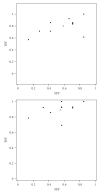Simpler evaluation of predictions and signature stability for gene expression data
- PMID: 20111740
- PMCID: PMC2810473
- DOI: 10.1155/2009/587405
Simpler evaluation of predictions and signature stability for gene expression data
Abstract
Scientific advances are raising expectations that patient-tailored treatment will soon be available. The development of resulting clinical approaches needs to be based on well-designed experimental and observational procedures that provide data to which proper biostatistical analyses are applied. Gene expression microarray and related technology are rapidly evolving. It is providing extremely large gene expression profiles containing many thousands of measurements. Choosing a subset from these gene expression measurements to include in a gene expression signature is one of the many challenges needing to be met. Choice of this signature depends on many factors, including the selection of patients in the training set. So the reliability and reproducibility of the resultant prognostic gene signature needs to be evaluated, in such a way as to be relevant to the clinical setting. A relatively straightforward approach is based on cross validation, with separate selection of genes at each iteration to avoid selection bias. Within this approach we developed two different methods, one based on forward selection, the other on genes that were statistically significant in all training blocks of data. We demonstrate our approach to gene signature evaluation with a well-known breast cancer data set.
Figures
Similar articles
-
Outcome prediction based on microarray analysis: a critical perspective on methods.BMC Bioinformatics. 2009 Feb 7;10:53. doi: 10.1186/1471-2105-10-53. BMC Bioinformatics. 2009. PMID: 19200394 Free PMC article.
-
A potential prognostic long non-coding RNA signature to predict metastasis-free survival of breast cancer patients.Sci Rep. 2015 Nov 9;5:16553. doi: 10.1038/srep16553. Sci Rep. 2015. PMID: 26549855 Free PMC article.
-
A comprehensive sensitivity analysis of microarray breast cancer classification under feature variability.BMC Bioinformatics. 2009 Nov 26;10:389. doi: 10.1186/1471-2105-10-389. BMC Bioinformatics. 2009. PMID: 19941644 Free PMC article.
-
A Signature That May Be Predictive of Early Versus Late Recurrence After Radiation Treatment for Breast Cancer That May Inform the Biology of Early, Aggressive Recurrences.Int J Radiat Oncol Biol Phys. 2020 Nov 1;108(3):686-696. doi: 10.1016/j.ijrobp.2020.05.015. Epub 2020 May 17. Int J Radiat Oncol Biol Phys. 2020. PMID: 32434041
-
Identification of a 6-gene signature for the survival prediction of breast cancer patients based on integrated multi-omics data analysis.PLoS One. 2020 Nov 10;15(11):e0241924. doi: 10.1371/journal.pone.0241924. eCollection 2020. PLoS One. 2020. PMID: 33170908 Free PMC article.
Cited by
-
Systems biology and cancer: promises and perils.Prog Biophys Mol Biol. 2011 Aug;106(2):410-3. doi: 10.1016/j.pbiomolbio.2011.03.002. Epub 2011 Mar 23. Prog Biophys Mol Biol. 2011. PMID: 21419159 Free PMC article. Review.
References
-
- Schena M. Microarray Analysis. New York, NY, USA: Wiley-Liss; 2003.
-
- Michiels S, Koscielny S, Hill C. Prediction of cancer outcome with microarrays: a multiple random validation strategy. The Lancet. 2005;365(9458):488–492. - PubMed
-
- Hastie T, Tibshirani R, Friedman J. The Elements of Statistical Learning: Data Mining, Inference, and Prediction. New York, NY, USA: Springer; 2001. (Springer Series in Statistics).
Publication types
MeSH terms
LinkOut - more resources
Full Text Sources
Medical
Miscellaneous

